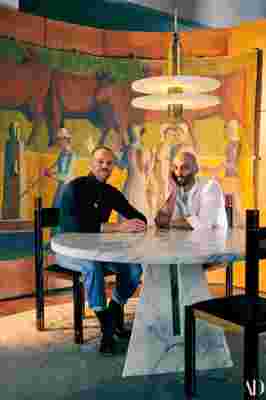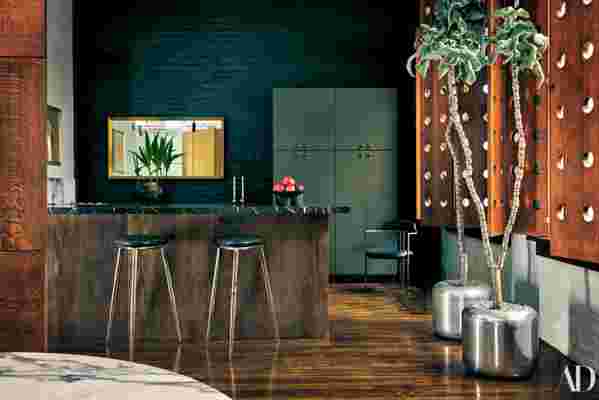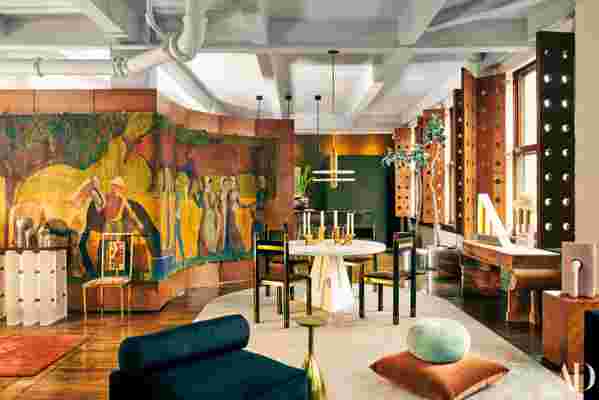
Anderson (left) and Hendifar.
The New York City home of Apparatus founders Gabriel Hendifar and Jeremy Anderson feels very much like one of the company’s signature lighting designs. They share a strange kind of beauty, highly refined and seriously seductive. A similar vibe pervades Apparatus’s famously swanky Manhattan showroom, as well as the lavish annual fête that Hendifar and Anderson throw there every spring. At a time of increasing sameness, when designers across the globe draw from a communal digital well of inspirations and influences, the Apparatus aesthetic remains blissfully, unapologetically idiosyncratic.
“Many of our product designs and collections evolved directly from pieces we made for ourselves. As much as this loft functions as a creative laboratory, it’s also our home. We set a high bar for the things we live with and the things we put out into the world,” says Hendifar, who serves as Apparatus’s creative director. “Besides, we always need a project to chew on to keep the creative juices flowing.”
Located on the top floor of an erstwhile industrial building in the Flatiron District, the loft speaks volumes about the Apparatus brand and the passions of its protagonists. Filled with prototypes, custom pieces, peculiar objets de vertu, and compelling architectural details, the residence strikes a delicate balance between the raw and the cooked. “We wanted to experiment with living in a semiformal way in a space that resists formality. Basically, we tried to make it feel less like a loft,” Anderson says of the couple’s design approach.
"We set a high bar for the things we live with and the things we put out into the world."
Two primary architectural interventions set the tone for the experience. The first is a semi-freestanding wall that defines a generous entry vestibule off the elevator. Paneled in quarter-sawn oak on one side, the wall snakes into the heart of the loft, where it discreetly delineates individual areas—dining room, kitchen, master suite—within the open expanse. In a decorative coup de théâtre, Hendifar and Anderson adhered a 15-foot-long, unframed, 1930s Danish canvas to the meandering divider. “We loved the idea of this giant pastoral painting of cows and milkmaids juxtaposed with all the sleek brass and marble. Plus, I really got off on designing the hardware that holds it in place,” Hendifar explains.
The apartment’s second defining feature is a series of custom oak shutters punched with symmetrical apertures. The repeating circle motif nods to Jean Prouvé’s ribbed-aluminum porthole panels, but the scale of the pattern and the inset rings of hand-finished brass keep the design squarely within Apparatus territory. “The first thing we did when we got this place was take down the roller shades on the giant, nine-foot-tall windows. The shutters immediately unified and elevated the architecture,” says Anderson.

1950s barstools stand at the brass-clad, Saint Laurent marble-topped kitchen island.
Throughout the home, the designers paired Apparatus lighting and furniture with sympathetic vintage pieces both pedigreed and unattributed. The living room, a tour de force of eccentric chic, exemplifies the duo’s sensibility. Midcentury sofas by Milo Baughman are covered in a black faux-bois moiré fabric that provides a dramatic counterpoint to the warm red-toned wood shutters. The room is anchored by an imposing Hendifar-designed cabinet constructed of brass mesh, wood, and eel skin, set atop turned legs of solid brass. Flanking the cabinet are two folk-art liquor cupboards in the shape of human figures, acquired from a hunting lodge in Maine. Hendifar bumped up the surrealism of the ensemble by adding a custom marble-topped cocktail table in the shape of a three-toed foot.
The look of the couple’s master bedroom can be summed up in two words: come-hither. Sheathed in rust-colored velvet and centered on a brass bed with a Persian lamb bolster set into the headboard, the space echoes the crazy-sexy-cool vibe of disco-era debauchery. Even the mirror-fronted closets and the meshugenah Vladimir Kagan Omnibus lounge in the adjacent dressing room have an undercurrent of 1970s louche. As a final flourish, a small painting of Anderson’s ear that Hendifar commissioned for his partner’s 40th birthday hangs above the bed. “It was the perfectly right wrong thing to put there,” Hendifar avers.

The bedroom carpet—an unexpectedly traditional American design from the 1940s—is something the couple acquired when they lived in Los Angeles, before the pair took Manhattan by storm in 2011. Likewise, the large French Deco–ish cabinet that presides over the entry hall and the curious Asian-inflected altar table in the dining area are both L.A. imports. “They’re not only great designs but also mementos of our shared life and history. We always find a place for them,” Anderson says.
Indeed, as the story of the couple and the brand they created continues to evolve, the loft contains hints of what we might expect to see from them in the future. Anderson, for instance, has quietly been experimenting with ceramics, and the fruits of his labors are on display throughout the apartment. True to form, his subtly anthropomorphic vessels have a peculiar poetry that jibes with the overall spirit and allure of the couple’s work. To borrow a phrase from Marvin Gaye and Tammi Terrell, when it comes to strange beauty, “Ain’t nothing like the real thing, baby.”
